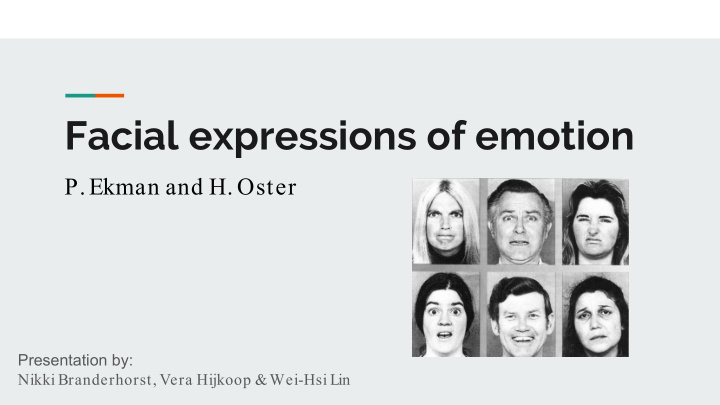



Facial expressions of emotion P. Ekman and H. Oster Presentation by: Nikki Branderhorst, Vera Hijkoop & Wei-Hsi Lin
CROSS-CULTURAL STUDIES AND THE ISSUE OF UNIVERSALITY ● Emotions are labelled the same way regardless of culture. ● Members of different cultures generally show the same facial expressions of emotion ○ Culture-specific display rules
DEVELOPMENTAL STUDIES ● Imitation of facial movements ● Preschool children know the most common facial expressions ● Social communication
ACCURACY ● Facial expressions of emotion can provide accurate information about emotional states ● Facial expressions can be disguised ● Individual differences
FACIAL FEEDBACK ● Self- attribution theory ● Overt facial expression ○ Subjects showed less intense facial expression when they were told that they were being observed. ○ People are more likely to smile when interacting with others than when they are alone (Fernández Dols & Ruiz Belda, 1995; Fridlund, 1991).
POSITIVE POINTS ● Extensive literature review on several relevant topics on research on facial expression of emotion ● Include relevant criticisms, unanswered questions & suggestion for further research structured by topic
CRITICISM ( on research topic and paper ) ● Self-reported emotion is subjective ● “Artificial” emotion in lab settings ● Influence of posture and voice is often not considered ● The reviewers Ekman & Oster may be subjective in reviewing their own work.
RESEARCH QUESTION “ Do people show emotions through facial expression differently toward robots than towards humans? ” ● Previous study about robot & human emotion focus on robots ● Combine the findings of current study ○ People convey emotion through facial expression ○ Facial expressions can be disguised or manipulated in social interaction ● Generalize to human-robot interaction?
RESEARCH QUESTION Method ● Between-group design ● Dependent variable: emotional intensity & facial expression ● Independent variable: human / humanoid robot / technical robot ● Procedure a. Watch a video clip b. Self-reported emotional intensity evoked by the clip c. Describe the plot and feelings to a person / humanoid robot / technical robot d. Record facial expression & self-reported emotional intensity about the conversation
RESEARCH QUESTION Expected results ● People disguise or manipulate emotions in social situations (Graaf, 2016). ● People show more genuine intensity in facial expressions of emotion when communicating with a technical robot ● Facial expression are less aligned with the emotion they reported when interacting with human / human- like robot
RESEARCH QUESTION ● Conclusion ○ Research on a robot’s ability to express emotion, the perception of a robot’s facial expression and facial expression recognition ( Bartlett, littlework, Fasel & Movellan, 2003) has been studied extensively in the HTI domain recently. It would be interesting to explore how people show emotions and intensity of these emotions through facial expression towards robots.
Recommend
More recommend